When it comes to roofing, one size certainly does not fit all. The distinctions between commercial vs. residential roofing stretch beyond mere scale and delve into intricacies like design, material choices, and purpose. Each type serves a unique set of requirements and faces its own challenges.
Whether you're a business owner deliberating on the best roofing solution for your enterprise or a homeowner pondering over shingle types, understanding these key differences is crucial. This article delves deep into the nuances of commercial and residential roofing, highlighting their disparities and considerations to help you make informed decisions for your structures.
Dive in to explore everything from design variations and material options to installation techniques and cost implications.
When it comes to the world of roofing, both residential and commercial structures have their unique design characteristics and structural requirements. These differences are not merely for aesthetic reasons; they also cater to specific functional needs and challenges that each type of building presents.
Let's explore the primary design and structural distinctions between the two:
In conclusion, while the fundamental objective of residential and commercial roofs is to protect the structure below, the design and structural challenges they each face are distinct. Understanding these differences is vital for making informed decisions about roofing materials, design choices, and maintenance strategies.
Both residential and commercial roofs have distinct requirements, resulting in varied material preferences. These choices reflect each roofing type's specific demands, design considerations, budget constraints, and longevity expectations. Here's a breakdown of the popular materials used in both sectors:
Factors like climate, building needs, structural capacity, and budget are crucial when choosing materials. The objective is to prioritize protection, durability, and value. Collaborating with roofing experts ensures decisions tailored to individual needs.
When embarking on a roofing project, understanding the expected duration and the techniques employed is essential. Both installation time and technique can vary significantly between residential and commercial roofing due to their distinct characteristics and requirements.
Let's break down the differences:
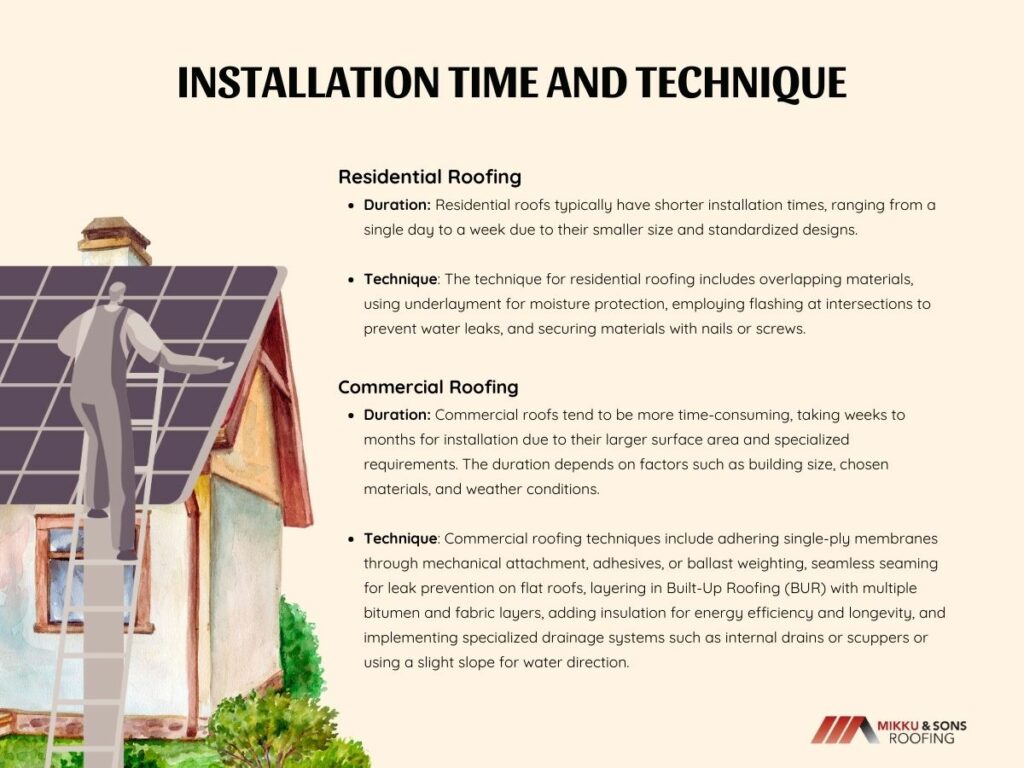
Residential roofing is simpler with faster completion, while commercial roofing demands a detailed approach due to its size and unique needs. Regardless of the project, partnering with expert roofers ensures top-quality installation, long-lasting effectiveness, and enduring performance.
Roofs’ exposure to varying conditions necessitates periodic maintenance and inevitable repairs. However, the approach and frequency differ between residential and commercial roofs due to their inherent design and material differences.
Here's a closer look at the maintenance and repair considerations for each:
In a nutshell, regular roof maintenance, whether for homes or businesses, can prevent costly repairs. Addressing small issues early and collaborating with expert roofers keeps the roof in top shape, ensuring the building and its occupants remain protected from the elements.
One of the most pivotal factors in any roofing decision is cost. Both initial installation and long-term expenses play a significant role in determining the roofing choice for residential and commercial structures.
Here’s a detailed look into the cost considerations for each:
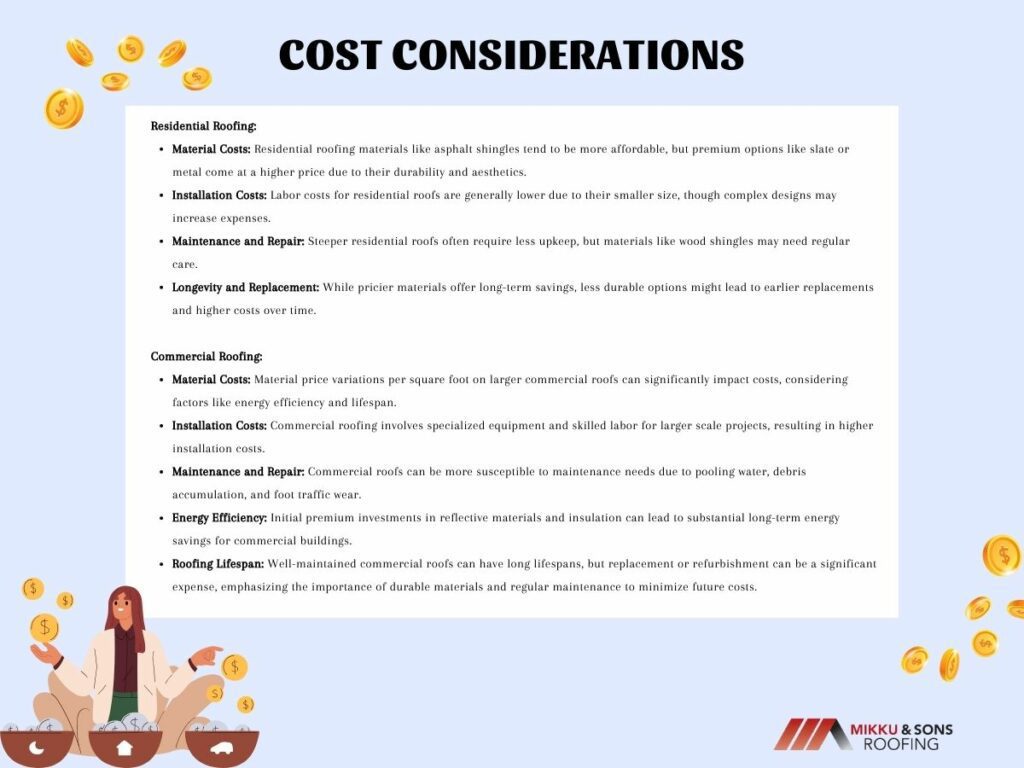
While the initial installation cost is a crucial factor in residential and commercial settings, it's essential to consider the bigger picture. Long-term costs related to maintenance, repairs, energy efficiency, and replacement intervals can influence the overall financial implications of a roofing choice.
It's always recommended to consult with roofing professionals to get detailed estimates and understand the cost-benefit analysis of different roofing options.
The world of roofing is vast and varied, with each type tailored to meet specific needs and challenges. Commercial and residential roofing, while sharing the core objective of protection, have marked differences in design, materials, installation, and maintenance.
Whether you're safeguarding a family home or a bustling business hub, being informed about these distinctions is essential. By understanding the unique considerations of each, property owners can ensure their roofing choices not only offer optimal protection but also provide value for money.
Collaborating with seasoned roofing professionals will guide you in making decisions that stand the test of time, weather, and wear.
When it comes to maintaining commercial roofs, the importance cannot be overstated. Not only does it protect your investment, but it can also save you a considerable amount of money in the long run. So, what are the best practices for maintaining commercial roofs?
In this blog, we'll explore the significance of commercial roof maintenance, the cost-saving benefits it offers, and how it can extend the lifespan of your roof. Additionally, we'll delve into essential practices such as inspection, cleaning, gutter maintenance, roof repairs, and more.
Commercial roofs are the unsung heroes of your business infrastructure. They shield your valuable assets, equipment, and employees from the elements day in and day out.
However, they are also constantly exposed to harsh weather conditions, UV rays, and wear and tear. Commercial roofs can quickly deteriorate without proper maintenance, leading to costly repairs and premature replacement.
Regular roof maintenance offers several crucial benefits:
Investing in regular commercial roof maintenance may seem like an additional expense, but it's a smart financial decision. Here's how it can save you money:
Commercial roofs are designed to last, but they need care to fulfill their potential lifespan. Here's how proper maintenance can help prolong the life of your roof:
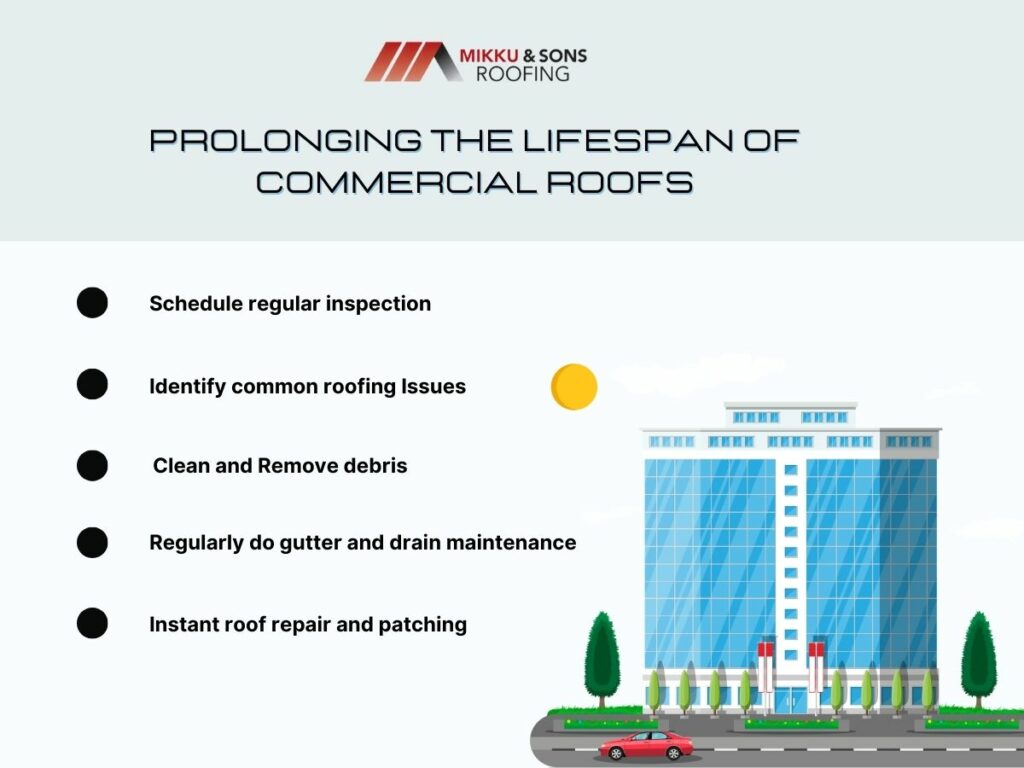
Scheduled inspections are the backbone of effective roof maintenance. By inspecting your roof at least twice a year, you can catch issues in their early stages, preventing them from becoming major problems.
Understanding the common problems that afflict commercial roofs is crucial. These include:
A clean roof is a healthy roof. Here's why cleaning and debris removal matter:
Proper drainage is essential for a healthy roof. Here's how to maintain gutters and drains:
Addressing issues promptly can prevent them from worsening. Here's how to tackle roof repairs:
Commercial roofs are a significant investment for any business, and their lifespan can vary depending on various factors.
The longevity of a commercial roof depends on the type of roofing material used, the quality of installation, the local climate, and the level of maintenance it receives. Here's a general overview of how long commercial roofs can last:
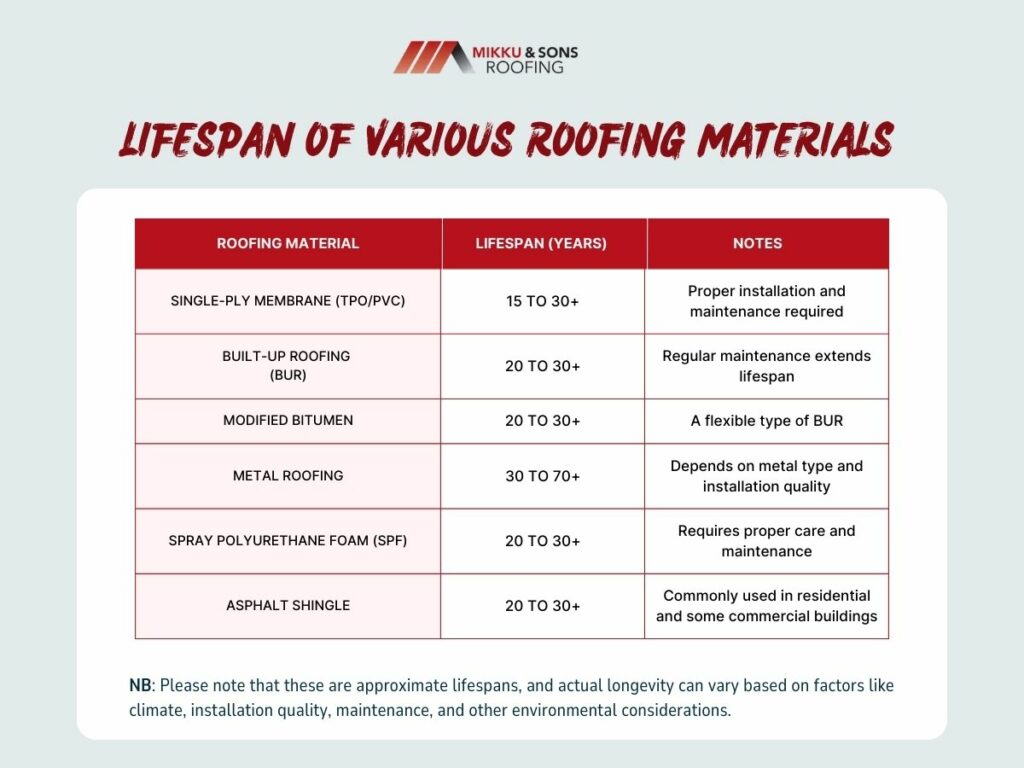
It's essential to note that environmental factors can significantly influence the lifespan of a commercial roof. Roofs may wear out more quickly in areas with extreme weather conditions, such as intense heat, heavy rainfall, or severe storms.
Additionally, proper maintenance plays a crucial role in extending the life of a commercial roof. Regular inspections, restorations, and cleaning can help identify and address issues before they become major problems.
The importance of maintaining your commercial roof cannot be overstated. It serves as a crucial shield protecting your investments and assets. By investing in regular maintenance, you not only save on costly repairs but also extend the lifespan of your roof, ensuring long-term durability and energy efficiency. From inspections to cleaning, gutter maintenance, and timely repairs, these best practices are your key to safeguarding your commercial space and financial well-being.
Roofing is a critical component of any home, as it provides protection from the elements and contributes to the overall aesthetic appeal. While there are various roofing materials to choose from, metal roofing has become increasingly popular among homeowners due to its numerous advantages.
However, like any material, metal roofing comes with its own set of drawbacks. This article will explore the pros and cons of metal roofs for your home.
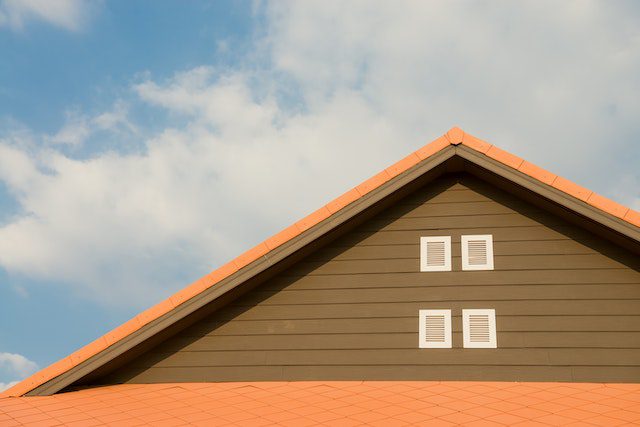
Metal roofs have become an increasingly popular choice as they offer numerous benefits. In fact, metal roofs have emerged as an attractive alternative to traditional roofing materials.
Here are some advantages of metal roofs, providing homeowners with the information they need to make an informed decision.
One of the most significant benefits of metal roofing is its exceptional durability. Metal roofs are resistant to cracking, shrinking, and eroding, making them an excellent choice for long-term use. They can withstand harsh weather conditions, including heavy rain, hail, snow, and high winds.
With proper maintenance, a metal roof can last for 40 to 70 years or more, far outlasting traditional asphalt shingle roofs, which typically last for 20 to 30 years.
Metal roofs are highly energy-efficient due to their reflective properties. They reflect solar radiant heat, reducing the amount of heat absorbed by your home. This can decrease cooling costs during hot summer months by up to 25%, saving you money on your energy bills.
Metal roofs also provide better insulation during colder months, helping to maintain a comfortable indoor temperature and reducing heating costs.
Metal roofs are eco-friendly, made from recyclable materials, and can be recycled at the end of their life cycle. This helps reduce the environmental impact of roofing waste in landfills. Additionally, the energy efficiency of metal roofs can contribute to a smaller carbon footprint for your home.
Compared to other roofing materials, metal roofs require minimal maintenance. They are resistant to mold, mildew, and pests, reducing the need for frequent repairs or replacements. Occasional inspections and cleaning are generally all needed to maintain a metal roof's longevity and performance. This low maintenance aspect can save homeowners both time and money in the long run.
Metal roofs come in a wide range of colors, styles, and finishes, allowing homeowners to select a design that complements their home's architecture and personal taste. Modern metal roofing materials can mimic the appearance of other materials, such as wood shakes, clay tiles, or slate, providing a sleek and sophisticated look. Metal roofing can enhance the overall aesthetic of a home, potentially increasing its resale value.
Metal roofs are non-combustible, making them an excellent choice for fire-prone areas. They have a Class A fire rating, the highest rating available for roofing materials, which can provide homeowners with peace of mind and potentially lower insurance premiums.
Metal roofing materials are relatively lightweight compared to other options like tile or slate. This reduced weight puts less stress on your home's structure, making metal roofs an ideal choice for both new construction and re-roofing projects.
While metal roofs have gained popularity due to their numerous benefits, it's essential to be aware of the potential drawbacks associated with this type of roofing material. With that, here are some disadvantages of metal roofs, providing homeowners with a comprehensive understanding of the potential challenges they may face when choosing this roofing option.
One of the primary drawbacks of metal roofing is the higher upfront cost compared to other materials like asphalt shingles. The investment can be substantial, but it's important to consider the long-term benefits, such as durability, energy efficiency, and low maintenance.
In many cases, the overall cost of ownership may be lower over time, but homeowners must be prepared for the initial expense.
"Our real estate company buys houses in Mishawaka, IN and metal roofs are popluar style there. We have noticed a lot of real estate compnanies that fix and flip properties will install shingle over metal roofs in most cases because of the economics. However, if its your home and you want it to stand out then metal roofs are great in boosting your curb appeal!"
Matt Vukovich | Real Estate Investor in Mishawaka, IN

During heavy rain or hailstorms, metal roofs can be noisier than other roofing materials. The sound of raindrops or hail hitting the metal surface may be distracting or disruptive for some homeowners. However, this issue can be mitigated by installing proper insulation or noise-reducing underlayment during installation.
Metal roofing installation requires skilled professionals with experience in handling the material. Choosing a reputable and experienced contractor for the installation is essential to avoid any potential issues down the line. Improper installation can lead to leaks, poor performance, and reduced lifespan.
Additionally, finding a qualified installer in your area may be more challenging compared to finding an installer for more common roofing materials.
Metal roofs can expand and contract as the temperature changes, which may cause some panels to become loose or warp over time. However, modern metal roofing systems are designed to accommodate these changes, and proper installation can minimize potential issues.
Nevertheless, the expansion and contraction in extreme temperature fluctuations may lead to more significant problems that require repairs or roof replacement.
In the event of damage to a metal roof, repairs can be more complicated and costly than with other materials. In some cases, it may be necessary to replace entire panels rather than repairing small sections. This can make repairs more expensive and time-consuming.
Additionally, finding a contractor skilled in metal roof repair may be more challenging, as it requires specialized knowledge and expertise.
While metal roofs are highly durable, they are not entirely immune to damage. Metal roofs can become dented in extreme cases, such as severe hailstorms or falling debris.
Some types of metal roofing, like aluminum and copper, are more prone to denting than others, like steel. While dents do not necessarily compromise the roof's performance, they can be unsightly and may require professional repair to restore the roof's appearance.
While metal roofs are available in various styles and colors, they may not fit every home's aesthetic best. Some architectural styles, like traditional or historic homes, may not be compatible with the modern look of a metal roof. In these cases, alternative roofing materials may be more appropriate to maintain the home's overall aesthetic.
Metal roofs are an increasingly popular choice for homeowners seeking a durable, energy-efficient, and environmentally friendly roofing option. While the initial cost may be higher than other roofing materials, the long-term savings in maintenance and energy costs can make it a wise investment.
However, it is essential to consider the potential drawbacks, such as noise, installation challenges, and limited repair options. By carefully weighing the pros and cons of metal roofs, homeowners can decide on the best roofing material for their unique needs and preferences. Ultimately, a well-installed and maintained metal roof can provide lasting protection and curb appeal for your home.
Roofs protect a structure as well as its contents from the elements. They are installed with materials that have estimated lifespans which can be compromised at any given time without proper care and maintenance.
Commercial roof inspections require extensive skill and understanding. Commercial roofs are often larger and have a lower slope or are completely flat and are therefore more difficult to maintain.
When inspecting your roof, it's not enough to look for rust or water spots or take a walk around the perimeter of your building. Routine inspections and minimal maintenance can help building owners prevent costly problems due to the changing seasons and temperatures.
This article details 10 tips on how to inspect a commercial roof.

Roof inspections save money by preventing costly repairs and identifying problems early before they develop. Property owners utilize inspection data to allocate maintenance funds.
Maintaining the roof helps reduce the risk of lawsuits because when it comes to your health and your wallet, a poorly maintained roof can be dangerous. Maintaining your roof might save you money because roof maintenance typically reveals minor concerns that can be fixed before they become huge, costly problems.
Roofs should be inspected often to prevent damage to sensitive equipment. Building inspections discover flaws and protect staff and others safe. It helps property owners with preventative maintenance.
To avoid major problems, commercial building owners need to keep their roofs in good condition. Without regular inspections, your building could be closed as regular roof, and facade inspections keep buildings safe, efficient, and in good shape.
Commercial roofs may need more frequent inspections than the twice-yearly spring and fall checks. Roof inspections may discover repair opportunities and sites for telecom towers or solar panels, allowing you to monetize your roof.
| Tip | Importance |
| Detailed roof inspection | Shows areas that need attention |
| Clean debris | Reveals any damage and prevents roof damage |
| Inspect for ponding water | Prevents roof failure |
| Look at the flashing | Ensures no developing roof damage through leaks |
| Check the roof for cracks or tears | Prevents any damage to the roof interior through leaks |
| Inspect the parapet walls, if any | They are areas at risk of water damage |
| Check the drip edges | They prevent interior roof damage |
| Inspect the roof surface | Reveals any developing damage |
| Inspect the gutters | Clogged gutters may promote pooling on the roof |
| Check the downspouts | Downspouts direct water away from the gutters |
An assessment of a building's roof is a serious matter that should be handled by a roofing professional. Commercial building owners should get an industrial roof inspection at least twice a year to ensure that their roofs are in good condition and safe.
Inexperienced roofers may cause costly repairs that may have been avoided if a competent business roof contractor had conducted the checks. There are many issues that could befall your roof at any time during the year.
Many issues might arise during commercial building inspections, but only if you hire a qualified inspector who knows how to do each of these processes correctly. That way, you can avoid the need for costly roof repairs when the damages become worse.
1. Conduct a detailed roof inspection
In order to guarantee that your commercial roof remains in good condition, you must do a thorough examination.
You can only address a problem if you are aware of it, and you can do so by knowing the problems. The following are some of the problems that a professional inspection will illuminate for you:
Commercial roof inspections allow you to catch problems before they become a big problem. Before the cold weather sets in, inspect the roof for any damaged flashing, buckling, or split seams.
Problems like wind-related cracks and clogged gutters can be identified in an inspection before they become costly damages that require repair. Summertime breezes can develop little cracks that can grow during the winter.
Make sure you get in touch with a reputable commercial roofing contractor who can identify any potential issues. Check the commercial roofing checklist with your inspector to see if there are any obstacles or clogs.
2. Clean Debris
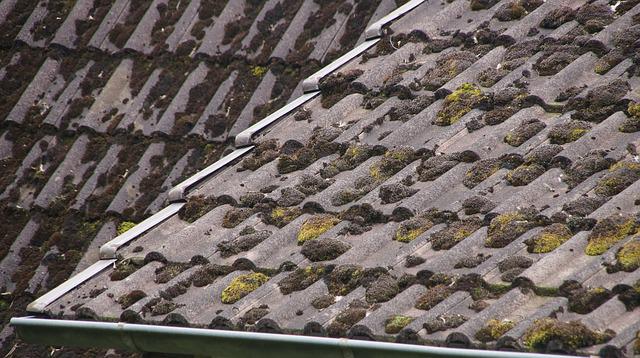
Keeping your roof clean and clear of snow, ice, debris, and other natural elements can ensure its longevity and reduce property damage.
Algae and moss can damage your roof through shingle disintegration and wood rot. They can cause costly repairs, but this is eliminated through regular roof cleaning.
Regular roof cleaning prevents decay from the accumulation of dirt, moss, and algae. Cleaning your roof regularly is important for its structural integrity and the safety of your home and goods in any conditions.
Remove anything from your roof but consult a professional because as much as roof cleaning is possible, conducting it yourself can be dangerous. Debris on your commercial roof should be a priority as bird nests, or other animals can cause future difficulties.
A commercial roof's drainage system may be damaged by tree debris. Branches and leaves must be removed from drains and roof corners for water to flow freely.
3. Inspect for ponding water
Ponding occurs when water pools on a flat roof, forming ponds usually after a downpour. Most pools leak or evaporate, but a roof that doesn't drain rainwater for two days or longer, even while other parts of the roof are dry, is prone to pooling.
Water near roof drains can create color changes and stains. Check slow-draining lines and occluded areas for ponding.
An expert evaluation may reveal concealed water damage and determine the underlying damage. Before your roof inspection, remove any standing water but take photos of the damage before and try to determine how long it's been there.
Water ponding can damage your roof. Ponding water might cause roof leaks creating a habitat for termites, roaches, and beetles, which infest your roof and do considerable damage.
4. Look at the flashing
Flashing protects flat and slanted roofs against flooding. Stacks, walls, and curbs should be inspected for flashing. Check for cracks or breaches that could let water in before the rainy seasons.
Look for fractures that let water in, especially at the flat-to-vertical transition. Changeover points have more cracks, and other issues and leakages are more common, typical where the flashing connects to the roof.
Flashing surrounds skylights, chimneys, and vents on commercial roofs, and they keep water from damaging areas of the roof. Flashing stops rainwater from leaking into the roof deck, which manifests as peeling or splitting at the caulking.
Flashing protects a roof's most vulnerable parts. Thus, anyone evaluating the roof should pay careful attention to it. By maintaining your flashing, you may prevent roof leaks.
5. Check the roof for cracks or tears
A commercial roofing inspection is needed to determine whether the roof has structural damage from tears or cracks. A fractured roof surface can have serious repercussions if ignored, as your roof provides insulation, shelter, and energy efficiency.
The sooner you fix a roof tile crack, the better. Foot traffic, protruding nails, and intense storms produce roof cracks. Full horizontal or vertical breaks should not be repaired using adhesive. Valleys and penetrations are vulnerable to tears or cracks.
You may likely have to replace the roof if the damage is significant. You can conduct a flood test to check if the roof has tears or cracks. Flashing problems are easy to address if identified before the major water damage. Annual inspections ensure your roof's flashing remains watertight.
6. Inspect the parapet walls, if any
A parapet wall is simply a vertical extension of the wall. The walls protect the roof from water, air, and vapor and also aid in temperature regulation.
Corrosion and degradation of the roof or another pre-built nearby structure can be prevented by controlling these variables. Your roof's edge can be lifted and damaged by strong wind as a result of elevated wind pressures.
In order to determine if the wall is structurally sound, your expert inspector should check and address any concerns as soon as possible.
7. Check the drip edges
The edge of the roof's perimeter is covered in drip edge, which creates a watertight seal by keeping the underlayment in place. It is positioned exactly under the shingles and just above the facia.
A compromised drip edge allows water to seep into the roof under the underlayment. This is worse for the eave side of a roof that has clogged gutters.
It is imperative that all of these drip edges be anchored firmly and properly. Doing so will ensure that there are no openings in the structure that allow water, dirt, and other elements to get in.
8. Inspect the roof surface
The surface of the roof is the visible covering on the roof. The materials used on the roof covering vary in durability and how much maintenance they need.
Inspecting the edges of the roof is critical, especially along the windward edges, where storms are most likely to cause the roof covering to get lifted. During an inspection, look for any damage caused by the wind, which includes rips and tears.
The roof could also be damaged if it blisters in many parts of the roof. Blistering occurs when there are many air or moisture pockets that expand during hot weather to further damage the roof.
Everything on your roof that isn't part of the perimeter or flashing is referred to as the roof field. The deck of commercial roofing systems may reveal evidence of ripping in the membrane of the roofing system.
Any small invisible cuts on a roof may cause leaks. These can be identified through flooding, which is the method of testing the waterproofing system by allowing a regulated amount of water to remain on a horizontal surface for a predetermined period of time.
9. Inspect the gutters
Gutters play a role in directing rainwater from a roof down downspouts or water harvesting systems. Gutters on a commercial roof are important as the roofs are large and flat, therefore prone to pooling.
If the gutters are clogged, there is a high chance that water will pool on your roof. If the gutters sag or overflow during rainstorms, there is a high chance that the gutters aren't fully functioning.
PVC roof membranes on roofs don't quickly give way as a result of ponding, but other roof types, such as asphalt-based roofs, are more likely to fail. Remove any debris that has accumulated in the gutters to avoid this.
10. Check the downspouts
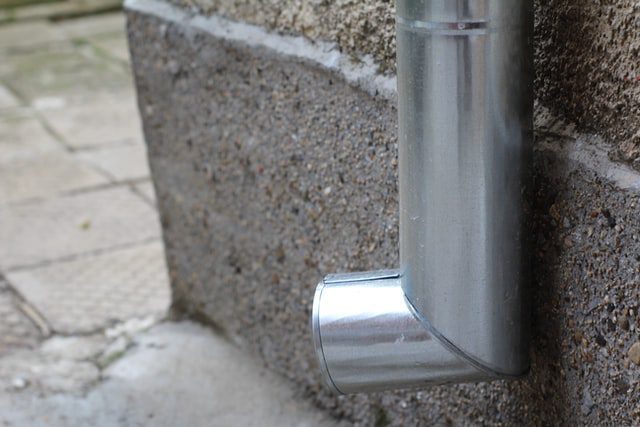
For your gutter system, the downspout serves as the outlet for the rainwater that falls from your gutters. Ground to roof inspection of your downspouts is important to assess whether the downspouts have been damaged or clogged.
Mechanical damage to the downspouts can occur when mowing grass or being crushed by an automobile like a forklift or something the sort. If there is mechanical damage to the downspouts, they will have to be fixed or, better, replaced.
Make sure your downspout water is directed away from your house so that it doesn't collect there. Pooling water at the base of a house damages the foundation as well as floods the basement if there are any open crevices.
Clogged gutters often direct some of the debris into the downspouts, and this can manifest as overflowing or sagging gutters during heavy rain. You can check if the downspouts are clogged by tossing a coin into it and checking if the coin will emerge from the bottom.

You can profit from employing an assessment checklist for commercial roofing projects, no matter how large or little they are. Controlling your company's operations is easier when everyone on your team is following a well-defined checklist.
A roof assessment checklist:
-Maximizes output and efficiency
-Minimizes errors and omissions
-Increases the effectiveness of roof inspections
-Cuts down on inspection times
-Customer satisfaction is improved.
-Facilitates the planning of tasks and managing staff
During the rainy or snowy days, roof leaks, frozen gutter drains, and an accumulation of snow might occur. A compromised roof will get damaged when this happens, and the best method to avoid these issues is to prevent them in the first place.
Roof damage may occur when it caves in if it's exposed to extremely windy or rainy circumstances and when cracks in your roof develop as a result of the expansion and contraction that temperature variations cause. These damages are all a result of thermal shock and roof structural failure.
Rainwater can also freeze in small fractures in the roof, posing a problem. As the temperature rises, the ice melts and expands the fissure and widens even further as the water freezes again.
Commercial buildings are the places where business is done. Commercial buildings include office buildings, retail spaces, warehouses, and other types of structures.
Sometimes the building owners don't feel the need for commercial roof restorations even with the advice of the building manager or facility manager due to the expense or mess of commercial roof restoration. This article explains the benefits of commercial roof restorations when you go out of pocket to do them.

Repairing a tiny section of the roof is not the same as restoring the entire roof. A complete roof replacement is much more expensive and time-consuming, while a roof restoration is much cheaper and done on a smaller scale.
Commercial and industrial buildings have low-slope, single-ply or steep-slope metal roof systems. They can benefit from the building roof restoration process where liquid coatings are applied to the roof, and roofing surfaces are completely encased in a watertight, reflective and seamless coating system.
Commercial roof restoration involves more labor and calculative steps compared to a residential roof. The roofs are often huge, and therefore the restoration is carefully done on a small scale over a large area to ensure that the huge roof is completely restored.
These are some of the steps taken during a roof restoration:
1. Inspection
Restoration all begins with a professional commercial roofing company performing an assessment of your roof. They search for evidence of leaks, such as wet insulation, mold development, and stains.
After the inspection, the roofing professional then puts together all the items and labor input and specialty required for the restoration. This is done from the inspection report to establish the extent of damage, the certain area's specialty required and the materials needed.
2. Cleaning
The cleaning comes first to start the work. The buildup of dirt and debris on the roof is removed using pressure washing, which creates a clean surface for optimal adhesion of the coating.
Cleaning up also exposes any damaged parts of the roof covered by the debris that doesn't show as damaged areas on the report.
3. Repair
Leaks and structural problems can be addressed after cleaning. Repair entails re-bedding loose layers and filling in any gaps on the roof, including repairing or replacing damaged roof cladding (damaged metal sheets, tiles or shingles)
The restorative membrane will not stick to the roof like paint, and primer is therefore sprayed on first, then the surface is prepared for sealing. The membrane coating is put on the surface, which protects your existing roof by sealing the surface.
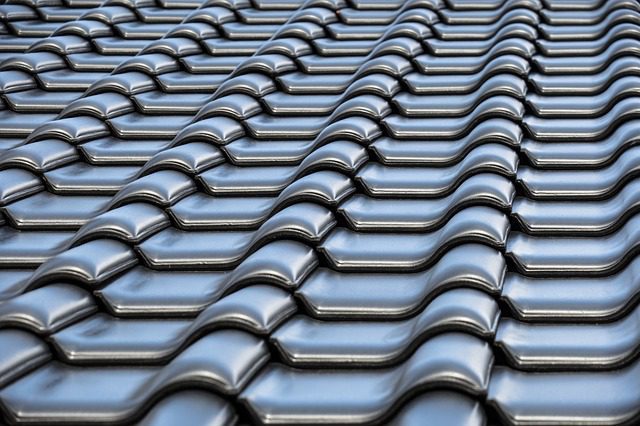
The restoration of a commercial roof has several advantages over a complete roof replacement or none at all. It can be a great way to extend the life of your roofing system.
Despite the fact that many roofing systems are built to last for decades while still providing outstanding performance, it is possible that roof restoration will be required in the future. Roof restoration might not seem appropriate at the moment, but in most circumstances, a roof restoration is a more cost-effective alternative to a complete roof replacement.
There are plenty of things to worry about while running a business or owning a commercial building, and a faulty roof shouldn't be one of them. If you let a leaky or otherwise deteriorating roof go long without fixing it, it could mean catastrophic problems down the road, including water damage, mold, rot, and more.
To understand more about commercial roof restoration and the benefits it can provide your business take a look at the following benefits for the most economical solution for your building.
1. Less expensive than a full roof replacement
When compared to a roof repair, a roof restoration might be equally as successful in solving your concerns. Roof replacement could cost up to $26 per square foot, while roof restoration could only cost up to $9 per square foot.
Regardless of the circumstances, the expense of repairing a roof is going to be high. Commercial building owners can save more than half of the cost of roof replacement by fixing their roof instead of replacing it.
Restoring a roof requires a lot less work and resources; thus, there are no additional costs. The cost of roof restorations is substantially less than the cost of replacing the entire roof.
Many of the benefits of a new roof can be achieved at a fraction of the expense through restoration. Because the existing roof isn't torn down, this technique involves less time and effort.
A roof restoration can not only save you money and effort, but it will also help you avoid a large loss in the future. To avoid the need for a complete roof replacement, get your roof fixed sooner rather than later.
2. Saves time as it is non-disruptive and quick
A full roof replacement necessitates more effort and may disrupt the building's daily routines. Some roof restoration can even be done as other activities take place since it is done in parts.
Since the tear-off process is omitted, it minimizes the impact on your business operations below the surface. Business shutdowns are more common in tear-offs than in restoration.
A roof replacement can take more than a month, while a roof restoration can be completed up to three times faster. There is, therefore, less interruption of the commercial activities and consequently fewer losses.
3. It is an environmentally friendly solution
Installing a new roof necessitates tearing off all of the old roofing materials, and enormous quantities of materials are thrown away or wasted, resulting in a large amount of landfill debris. Roof restorations use far fewer materials than new construction because rather than taking off old materials and replacing them with new ones, the existing roof is used as much as possible.
Since this roof system extends the life of your roof, it will be years before the debris from a full replacement needs to be deposited in the landfill.
A new roof generates a large amount of waste material that must be disposed of in a landfill. When a business roof is restored, its quality and sustainability are greatly improved, and less trash goes into landfills.
This is an environmentally friendly solution. It is also significantly easier to recycle the small debris that results from roof restorations.
4. An extended roof life
When a roof is constructed, it is done so with materials and workmanship that give it a certain lifespan. You may extend the life of your roof by 10 to 15 years if you are proactive and choose roof restoration before it deteriorates beyond repair.
When a roof is restored, it is coated with a protective layer to help it withstand the environment better. Under normal ponding water and the most extreme weather conditions like rain, snow, ice, sleet, or hail, the restoration systems remain adherent to the roof surface.
Due to the advantages of the entire restoration method, the expenses of maintenance are also cheap. You'll have enough time to save up and prepare for a roof replacement in the far future if you do this.
The normal lifespan of a commercial roof is between 15 and 20 years, but a restoration job can prolong the life of your roof by up to ten years if you deal with a reputable provider and maintain the coating properly.
5. An improved building safety
The success of a business not only depends on the merchandise or services but also on the conditions in which they are provided. The aging or damaged roof on a structure might pose a serious threat to the workers, clients and any commodities.
When moisture from a little leak builds up over time, it can swiftly cause mold and structural damage.
Mold can cause serious health issues to the workers and clients, while moisture can damage the wiring system in the sublayer and induce rot in wooden structures, which compromises a building's structural stability.
In addition to putting your business in jeopardy, a structurally deficient structure can also put your customers and staff at risk and should therefore be given immediate attention.
6. Reduced energy bills
A roof is constantly exposed to adverse weather conditions, such as UV radiation and freezing temperatures, because of its huge surface area. Running their air conditioning or heating systems may be a regular occurrence in an area that experiences frequent shifts in temperature.
A damaged part of the roof might be introducing cold or hot air from the environment, reducing the efficiency of the air conditioning and, therefore, higher energy bills to counter the effect. This is the same for a roof with compromised insulation which is critical to decreasing heating and cooling costs in commercial properties.
Solar reflectivity and emissivity are two properties that roofing systems commonly have, which can help your building become more energy efficient. You've probably noticed a lot of white top-coatings on flat roofs, which is an energy-saving measure.
The highly reflecting surface of the roof may help improve the life of your heating and air-conditioning systems because it minimizes the amount of heat in the building. In the summer, the reflective white coating keeps the structure cooler by reflecting sunlight saving you a lot of money over time.
The structure can be made more energy efficient by a roof restoration which has a greater impact on energy costs than you might believe.
7. Improved Resistance from the Elements
Commercial buildings may be subjected to harsh weather conditions depending on where they are located. A damaged roof is subject to leaks which cause mold and rot formation in its structures.
The damage will progressively get worse as time goes on if your roof is already in a state of degradation. Repairing a roof's weak spots will assist prevent future damage from the weather, especially extreme weather conditions like hurricanes and thunderstorms.
You will get a highly effective roof surface like the roof's surface will be protected by a watertight membrane that can halt leaks and lessen the need for roof repairs. If any further repairs are needed, the workers will have the opportunity to make them.

A well-maintained roof will, regardless, need to be replaced eventually due to the high expense of repairs. Some of these situations require a new roof instead of repairs.
Roof restoration is the extension of a roof's lifespan by fixing any damaged parts, while roof replacement involves tearing away the old roof and putting up a new one.
Repairing your roof is important before it becomes a real problem. As your roof deteriorates on a daily basis, it is always best to take a proactive strategy.
Each roofing situation is unique, and an earlier date of restoration increases the long-term success of the roof.
Most commercial roofs come with a warranty of 10, 15, or 20 years, depending on the manufacturer. A roof that is property restored might last up to 10 more years after it is restored.
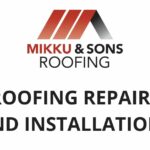
Are you looking for a roofing business in your area? Make a call to Mikku and Sons Roofing to discuss your options.
The type of roofing system you have doesn't matter; we've worked on it all: single-ply, metal, modified bitumen, and built-up. Schedule a commercial building inspection with our company today!
With the added complexity of installing a roof, replacing your home's roof is already a significant undertaking. Solar panels on the roof necessitate two additional steps in the roof replacement process.
Many people with solar panels installed on their roofs are baffled by this. Is it necessary to remove your roof's panels to install a new one? Are the solar panels going to be removed by the roofers, or will you have to contact your solar installer?
Is it possible to incorporate solar panels into the design of your new roof? Roofs and solar panels are inseparable. For some people, replacing their roofs before installing solar panels is recommended, but this isn't always possible.
Trying to figure out how to put solar panels on a roof? Continue reading our guide 'Roof Replacement with Solar Panels' for a few pointers to start your solar and roof journey.
Getting in touch with everyone involved in the removal and installation of solar panels is essential once you've worked out a strategy. Summer and peak roofing season can make this difficult.
As many solar installation companies are very busy, it is essential to get in touch with the company first to ensure that they charge you a reasonable price and secure your spot. Removing the panels can take up to six months on average.
Maintaining regular contact with the roofing contractor while working around the solar panel company's schedule is important. This way, the roofing company can order the necessary materials, schedule their delivery, and have their crew come out and install your roof on time.
After the solar company has reinstalled the solar panel system on the roof, it is critical to have the roofing company inspect the roof for any damage that may have occurred during the installation process. Some of the damages include:
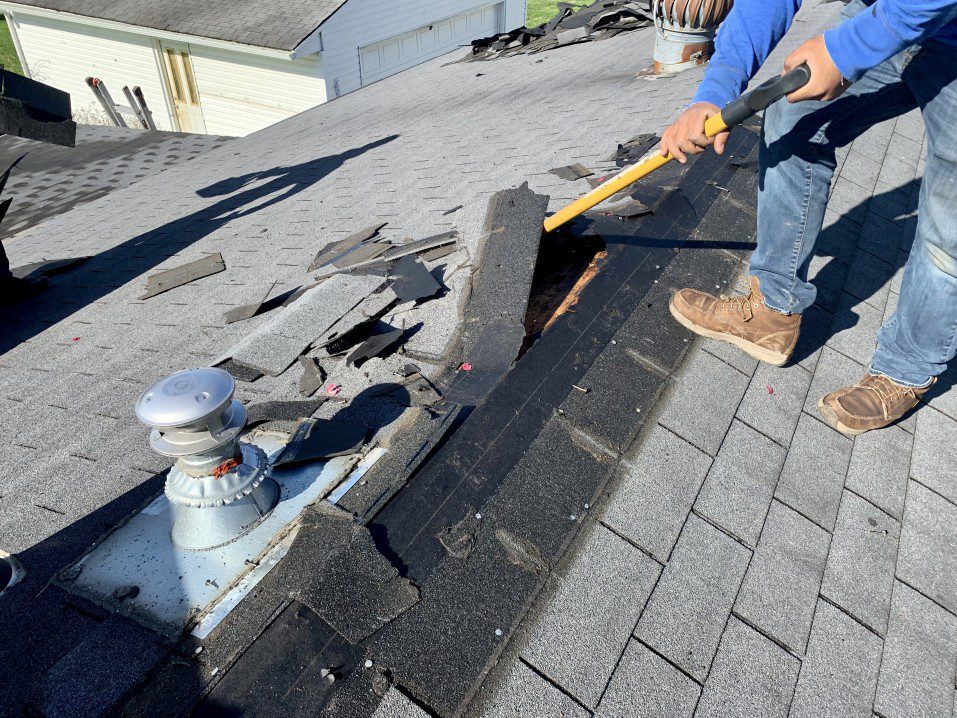
This can lead to increased water leakage and fire hazards, as the structure of the roof and its ability to withstand the elements are jeopardized. Roofing warranties can be voided if solar panels damage or compromise a roof.
Drilling holes into the roof is the most common, efficient, and cost-effective method for installing solar panels on a home's roof.
These holes need to be appropriately drilled and filled by licensed solar panel installers who know how to avoid damaging the roof during installation. If damage does occur, it is frequently the result of a previously unresolved roof issue.
Rather than caulk the hole or use an extra shingle, people with no extras on hand will sometimes place a piece of aluminum underneath the shingle, which almost always results in a leak. Roofing shingles can be ripped or torn when installing solar panels.
So, to ensure that the shingle seals properly and is watertight, the shingle must be replaced or caulked/repaired.

In theory, solar panels can be placed on top of an existing roof, but this isn't feasible because your roof comprises more than just the visible portion. Solar shingles can be used as a part of the roof, while solar panels can be used on top of the roof to generate power.
Compared to the installation of a complete solar roof made of shingles, solar panels are much faster. However, this does not necessarily make them the best option, as they will cost less upfront, which appeals to many people.
It would be best to familiarize yourself with the available solar panels before deciding which to use and how much they will cost.
It's important to weigh all of your options before deciding on whether or not to replace your roof with solar panels.
Besides, you may have a roof that needs replacing; solar shingles may be within your financial reach!
If your roof is nearing the end of its useful life, it may be a good idea to have it evaluated before installing solar panels. You should get an expert to inspect your roof if it's between five and ten years from needing to be replaced.
Solar companies don't typically offer roofing services, but a few exceptions exist. Your solar contractor is likely to have good recommendations for local roofers, and they may even be able to get you a discount on the cost of your roof replacement with solar panels.
In comparison to most roofing materials, solar panels are far more durable. With a roof replacement with solar panels, the new roof will last longer because of the panels' impact on the life of the old roof.
Additionally, if you're installing a new roof, it's unlikely you'll need to re-roof during the solar system's life, which is another benefit. You'll save money in the long run by not having to pay for the solar panels on your roof to be removed and reinstalled.
Before installing solar panels, replacing your roof is a good idea. Solar panels have a basic life expectancy of 20-25 years.
Because of this, solar panels can outlive their original roofs for many decades. Quite a few people have even relocated and taken their solar panels to their new location.
Regardless of your circumstances, learning how to replace a roof with solar panels is a valuable skill with an answer that's more straightforward than you might expect.
If you bought your solar panel system from a company or store that sells solar panels, you wouldn't have to figure out how to replace your roof. Contact your Solar Energy Specialist, and they'll help you out.

Ideally, your solar panels should be serviced by the company that installed them. As a result, you won't risk damaging them or voiding warranty claims. Your Solar Energy Specialist will handle the removal once you've contacted us.
When completing a roof replacement with solar panels, it's important to store your solar panels safely after they've been taken down. A safe distance from your roof replacement would be ideal for this new location.
Generally speaking, a garage or a shed will do just fine. Keep them away from your porch or front lawn at all times.
After installing the solar panels, your trusted roofers will begin removing your old roof. Removing the roof leaves a lot of debris, so maintain a reasonable distance away!
Installers will begin re-roofing your home once the old one has been removed. Dependent on the size of your roof and the roofing materials used, the time it takes to complete the job will vary.
Your solar installers will complete the re-installation on your new roof once the replacement work has been completed. If you have solar panels and batteries, this service also includes re-connecting them to the utility grid.
A new roof material may be considered when it comes time to replace your old one. Not all roofing materials use the same solar mounting brackets, whether they are more energy-efficient, durable, or affordable.
Changing materials may necessitate purchasing new mounting hardware, which can cost thousands of dollars.
To ensure that your new roofing material will work with your current mounting hardware, you should speak with the solar installers before the roof replacement is complete. As a result, your solar energy system installation won't be delayed by the need to wait for a new delivery.
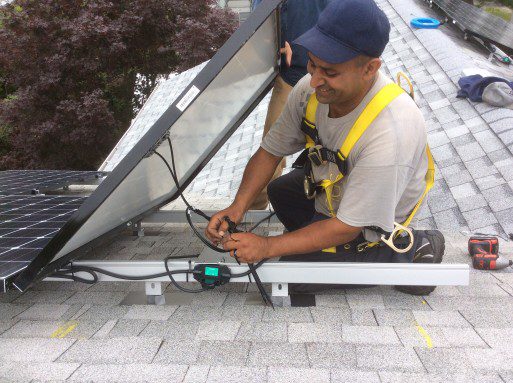
As a liaison between your roofers and your solar, you'll likely have to do some work. Keep in mind that you are in charge of your project, and you should be able to dictate exactly what gets done, how it gets done, and when it gets done.
Choosing a roofer willing to work directly with your solar installation company can make your replacement a lot easier. A more efficient and less stressful project will be achieved if you provide your solar installers with the contact information of your roofing company.
Have you given any thought to making the switch to solar power? Before beginning your project, many solar installers will inquire as to whether or not you've recently had your roof inspected for general health and quality.
A simple explanation for this is that you'll likely be told by your solar installer that you're better off replacing your roof before installing solar if yours has less than five years left of useful life.
Installing your solar panels and replacing your roof later will cost you thousands of dollars more than simply removing them and replacing them later, even if it is only for a short time.
Since most roofers lack the knowledge and experience to remove solar panels safely, it's best to contact your installers ahead of time and arrange for them to do so.
1. Cost: The initial investment in a solar power system is substantial
2. Weather-Dependent: Although solar energy may still be harvested on overcast and rainy days, the system's efficiency decreases.
3. Solar energy storage is pricey.
4. It uses a lot of space
Your house insurance may pay for your solar panels; as long as they are permanently attached to your house, they are covered by your homeowners' insurance policy's dwelling coverage.
However, if a covered risk damages your panels, you will receive compensation.
Shingles provide both protection for the roof and a cooling effect in the attic. I don't think solar makes replacing your roof more difficult. It would be more appropriate to use the term pricey. Finally, solar panels should only be installed on recent roofs.
Installing solar panels on a roof on the verge of needing replacement is a no-no for reputable solar contractors usually, they want it to be less than five years old.
The roof is protected by shingles, although this has little practical use. The advantage of lowering the temperature in the attic is likely more significant. Even though a partial roof replacement isn't ideal, it's necessary when it comes time. As a result, having solar-preserved shingles isn't all that important.
Flat roofs are ideal for Arizona's hot and dry climate; they are also a long-term investment for homeowners. These roofs can help keep the temperature down during the year's hottest months.
They are popular among homeowners in Arizona because of their ease of replacement and maintenance. When it comes to flat roofs, it is crucial to use the right materials and maintain them properly to enjoy the benefits.
These roofs are pitched between zero and ten degrees.
Adobe is a common building material, and many of Arizona's residences are constructed out of this venerable material. However, it has been replaced by lighter and more durable materials due to innovation.
As far as flat roofs are concerned, polyurethane foam roofing is the most popular option in Arizona. Polyurethane can tolerate the expansion and contraction of a building's structure, giving it an advantage.
It's light, strong, and completely seamless. Flat roofing alternatives in Arizona are plentiful, and these are some of the best.
Built-up roofs (tar or gravel roofs) are a well-known and widely used flat roof construction method that uses heated asphalt and alternating layers of roofing felt or fiberglass to create a long-lasting, durable roofing system.
When it comes to protecting a roof, asphalt(link) is a great option. Most tar-and-gravel roofs are expected to last at least 25 years, but if properly maintained, they can last up to 40 years.
This is owing to the materials' robustness, such as the embedded gravel, which does not degrade quickly. As a sun shield, the gravel on the roof's surface shields the material from damaging UV rays.
In Arizona, modified bitumen is a popular choice for flat roofing because it offers an excellent advantage for the hot climate. It can reflect solar heat from the roof.
This tough-yet-flexible waterproof membrane is created by mixing asphalt with polymerized rubber or plastic and then reinforcing it with fiberglass. It's also known as 'torch down roofing,' lasting between 10 and 15 years.
The energy efficiency and durability of foam roofs make them a popular choice, despite being one of the more expensive flat roof options. In Arizona, polyurethane foam is used to cover nearly all flat roofs.
Foam roofs are not only lightweight, waterproof, and low-maintenance, but they can also shield from the sun's UV rays. They are also easy to maintain.
Modern technology makes it feasible to manufacture strong roofs out of PVC. In the single-ply roofing sector, polyvinyl chloride (PVC) membranes have been hailed as one of the best materials for flat roofing.
The thickness of PVC roofing varies; the more layers you have, the more durable your flat roof is.
1. EPDM (Ethylene Propylene Diene Terpolymer)
EPDM (Ethylene Propylene Diene Terpolymer) is the most popular single-ply flat roof material for commercial and residential applications. It has simple installation, is lightweight, and is affordable.
It will last nearly indefinitely, even in hot climates like Arizona. A properly installed and maintained EDPM rubber roof should last at least 20-30 years.
Rubber roofs are installed by either being ballasted or by being adhered to. EPDM rubber costs $1.40 per square foot and $5.00 — $7.00 per square foot to install.
Rubber roofing that is adhered to the roof is stretched over a fiberboard or insulation board to produce an impenetrable, watertight seal.
In contrast, a ballast lies on top of the rubber roofing in a ballasted rubber roof. They aren't kept in place by tar, giving easy access if you need to access or replace the rubber roofing.
They often require regular maintenance because glue-based solvents are used, and eliminating all air pockets in the seals can be challenging to ensure a tight seal.
Fortunately, repairing one is still a simple and inexpensive process.
2. TPO membrane roofing
In Arizona, TPO roofs are an excellent option for homes because of their high heat reflectivity. It is exceptionally resistant to UV radiation and will not degrade from the regular sun exposure we see in the Southwest.
It costs $1.90 per square foot and $6.00 — $8.00 per square foot to install. Similar in color and appearance to PVC, white or gray TPO is a material stretched tautly over the roof's surface.
Polypropylene and ethylene propylene polymers are used in its construction, and depending on the use, TPO sheets may also be reinforced with polyester.
3. PVC membrane roofing
PVC is the most durable material on the market. It costs an average of $1.90 per square foot for materials and $6.00 — $8.00 per square foot for installation.
Roofs made of this plastic are impervious to extreme temperatures and elements such as wind and rain. Buildings in Arizona can benefit significantly from the heat-reflecting properties of this roofing material, which is why it is so popular.
Sheets of PVC are glued, mechanically connected, or ballasted to the surface. A hot-welding process eliminates seams, making PVC virtually leak-proof. It's so long-lasting that most manufacturers' warranties cover it for at least 25 years, if not a lifetime.
If you want a roofing material that won't fade or degrade in the sun, this is the one for you!

For built-up roofs and ballast roof systems, rocks or gravel on a flat roof are essential. The weight of the roof is evenly distributed by gravel or stone.
Due to the extreme heat and frequent storms, Arizonans expect their roofs to perform exceptionally well. The roofs need to be long-lasting and withstand the heat to some extent.
The two most common roof cladding in Arizona are shingle and tile.
Asphalt shingles are the most prevalent choice for roofs in Arizona since they are durable, lightweight, inexpensive, and simple to set up.
Flat roofs should not be covered with shingles. There is no way to seal the roof shingles. Thus, they will leak.
Tar, bitumen, rolled, or rubber roofing material is ideal for low-slope or flat roofs. Fortunately, this shouldn't be a problem in Arizona.
Asphalt shingles are available in a variety of styles, but the two most common include:
3-tab asphalt shingles are one of the most common types of asphalt shingles and the simplest.
They have a slate-like appearance, are flat, and are perfect for modest-sized homes. Due to their single layer of asphalt construction, they are lighter and less expensive than other varieties of asphalt shingles but have a lower wind rating.
They are made using multiple layers of asphalt that are bonded together to create a sturdy and thick appearance. They are heavier than basic strips because they are connected.
Compared to other asphalt roofs, they are more durable and have a higher wind rating.
Flat roofs are typical for residences and businesses in Phoenix and the surrounding suburbs. Flat roofs have both advantages and downsides, as this article describes.
| Advantages | Disadvantages |
| Cost: Flat roofs are less prone to damage and require less maintenance over their lifespan. They cost less in labor and materials during installation. | Style: Because they don't have the same aesthetic appeal as pitched roofs, flat roofs tend to stand out more in a neighborhood. They're not very attractive from the outside, but this doesn't necessarily mean you should avoid them altogether. While they have greater outdoor living space, they could also have less interior living space because there is no attic in the house. |
| Easy maintenance: Flat roofs are safer and easy to inspect regularly due to the absence of constant fear of falling from the roof; performing routine maintenance such as inspecting sidings, cleaning gutters, or even patching a hole becomes much more manageable. | Insulation: Flat-roof buildings are more susceptible to dramatic temperature changes. They have less attic space and therefore less air to maintain the heat lost by the house. This can lead to high utility bills during extreme temperatures. |

Flat roofs are great, but they require a little more attention than a sloping ones. Debris falls readily from a steeply inclining roof.
There are flat roofs, and it's easy for trash to build up. Keep your home flat roof in top shape with these easy-to-follow tips.
This is the most critical item on the list in terms of maintenance. Your roof will be flooded if the drains are clogged.
Water damage might occur due to a leak if there is standing water. Water damage can cost a lot of money.
Second, the additional water weight might cause the roof to collapse, resulting in a loss of structural integrity.
You need to sweep up leaves and dirt when they accumulate on your roof. Water can also be impeded from dripping off the roof by this debris.
Recoat your roof every 5 to 10 years to protect it from the sun's ultraviolet radiation and help it last 25 years or more.
What do you want to build? A house for your family or a place of business? Roofs are important parts of any construction, and investing in a good roof is essential to the intended function.
Flat roofs have the following advantages, to mention but a few.
| Benefits | Explanation |
| Fast installation | Measuring a sloped roof is more complex, and so is its construction. Installing most types of roof cladding is easier on a flat roof due to fewer safety concerns and other factors. Because flat roofs don't have seams, there are fewer places to seal. |
| They offer more space | You might use a flat roof on your home, apartment complex, or warehouse to save money. Flat roofs offer a wide range of possibilities for entertaining, growing food sustainably, and conducting business. Many people in metropolitan settings, where gardening space is few or nonexistent, convert flat rooftops into green spots where they can grow plants, such as fresh herbs, and cut down on grocery store visits. Property owners are drawn to this choice because of the ease of installation and the additional space. |
| Energy efficiency | Reflective paints and sealers help reduce heat accumulation and damaging UV radiation in your structure. Insulation in the attic and crawlspace can be reduced using reflective white roofing materials and membranes. Flat roofs also have less attic space, allowing the efficient dispersion of heat. |
As far as roof systems go, you may expect a roof to last anywhere from 10 to 50 years. Modern roofing materials can last a long time when properly installed and maintained.
Each roofing style has its pros, limitations, and environmental benefits. There are several aspects to consider when choosing a roofing material for your home, including how long it will last and how much it will cost to install and maintain it.
The lifespan of your roof is dependent upon several elements, including the overall design, quality of materials, the surrounding environment, and workmanship.
Living in an area with a lot of rain makes a roof susceptible to leaking, regardless of the construction quality. Flat roofs aren't an exception.
Instead of waiting for leaks or pooling, it's wise to seal flat roofs.
If your roof leaks, pools, or suffers structural damage, your roof needs a coating. If you don't see these indicators, a flat roof should be resealed every five years to protect it from water damage.
Flat roofs drain water and snow slower than pitched roofs. They are therefore susceptible to leaks if they are not adequately sealed.
Gutters are an essential part of a house, especially one in a rainy area. They divert and channel the rainwater to one area away from the foundation of the house.
They prevent soil erosion and damage to the foundation and also prevent or reduce basement flooding from water that may pool around the house.
Gutters are made from different materials that may present difficult choices for homeowners looking to install them. Two of these options are plastic and aluminum gutters.
Choosing aluminum vs. plastic gutters entails knowing their pros and cons, and in this article, we will help you choose the option that is right for you.
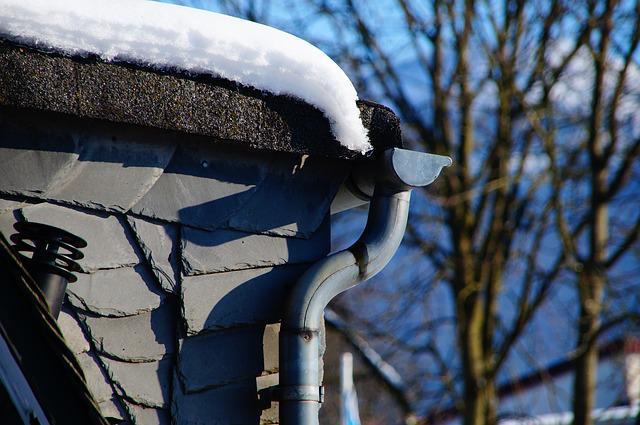
Aluminum gutters are the most common type of metal gutters. This is because they offer efficient gutter solutions with a range of advantages over other materials.
They make up most of the gutter systems in the US, and they can be constructed from primary or recycled aluminum. Seamed and seamless aluminum gutters are two of the most commonly touted types of aluminum gutters.
Seamless aluminum gutters are custom-made on-site and can only be obtained with professional installers. The seamed version is a decent solution for homeowners who want to install their own gutters.
The advantages of aluminum gutters
1. They are lightweight
Gutters are meant to hold and channel rainwater. During a heavy downpour, there is a lot of water running along the gutters that may sometimes overflow.
It is important to have gutters that can support the weight of the water as well as their own weight. Aluminum gutters are lightweight and can hold more water compared to other materials.
2. They are durable
Durability is an important factor when it comes to installing gutters to serve you in the long term. Aluminum gutters can withstand the weight of snow and hail and can last a long time without damage.
This is seen in most seamless gutters, which may last up to 20 years.
3. They are available in seamless options
Aluminum gutters are available both in seamless and sectional options. Seams are breaks in the length of gutters which can be okay for houses in moderate climate conditions but a huge problem for those in extreme weather conditions.
Rain, snow, and ice can cause gutters to sag when they accumulate in the system too quickly due to particular weather conditions.
Gutters with seams are at risk of separating, causing gutter leaks which cause damage to the roof and house.
Seamless aluminum and other metal gutter systems address this problem. A rolling machine is used by a skilled gutter installation crew to cut flawless, seamless aluminum gutter parts to fit your property.
4. They offer a wide choice of colors
Their widespread use has resulted in an abundance of options, including a wide range of colors and designs. To get the exact color you desire, you can paint them yourself.
Aluminum gutters come in a wide range of colors, making it simple to match them to the color of your house, roof, or exterior paint.
5. They require little maintenance
Since aluminum gutters are durable and don't rust, they can last longer compared to PVC gutters. They require little maintenance and can be painted to offer extra shelf life.
The enamel offers additional protection making the gutters last longer.
6. They are easy to install
The most popular gutter material is aluminum since it combines many of the advantages of other gutters into a single product.
It won't sag, and it's a lot lighter and easier to handle, making it easier to install.
7. They can be used in various climates
Aluminum gutters perform exceptionally well in any environment. Homeowners can have peace of mind knowing that when they install or have installed aluminum gutters, they are doing so for a very long time because they won't rust, corrode, or decay in the same way that older models did.
The disadvantages of aluminum gutters
1. They bend and dent easily
Heavy snow, hail, and wind can easily damage aluminum gutters, making them unsuitable for particular areas. They can be used with minor dents, but larger ones can hinder water flow and should be corrected.
Enamel is applied to the majority of metal gutters, but this coating eventually wears away. After some time, you'll have to paint your gutters to maintain them looking their best.
2. They can easily corrode in coastal climates
Aluminum doesn't rust, but it can corrode from protracted exposure to moisture and salt, which is a problem in coastal areas.
3. They wear off easily when in contact with less reactive metals
Aluminum is more reactive than copper, and in the presence of a common electrolyte, such as water with some ionic content, galvanic corrosion can occur between aluminum and copper.
If your roof has copper flashings or algae-resistant shingles, you should not install aluminum gutters. The aluminum will corrode faster because of the small amount of copper that washes off the roof.
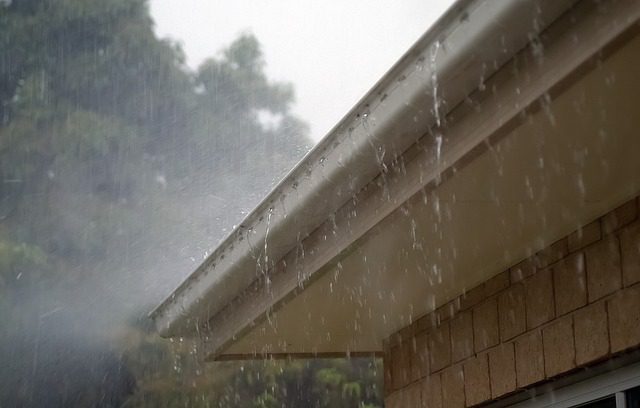
Plastic gutters, also known as vinyl or PVC gutters, are lightweight and are common options for gutter installations. They are still relatively new in the industry but and they have not yet surpassed aluminum gutters in terms of popularity.
Vinyl gutters are made of a type of PVC plastic that has been carefully formatted and adds a number of benefits exclusive to it.
They are generally the material of choice for many homeowners and contractors because of their PVC composition, which makes it an affordable and long-lasting material since it is one of the least expensive materials available on the market.
The advantages of vinyl gutters
1. They are durable
Vinyl gutters are exceptionally long-lasting due to their ability to tolerate heavy water and their invulnerability to bending or denting. This is even if they are unintentionally hit with a branch or ladder, for example.
In addition, vinyl does not rust, corrode, or deteriorate in any other way.
2. They are affordable
Vinyl (PVC) gutters have become an increasingly popular option, mostly as a result of their affordability and portability. These gutters may be purchased for about $3 to $5 for a 10 feet long section.
3. They are easy to install
Due to the fact that they are lightweight, they are simple to handle and set up.
It is not necessary to use joints or rivets because the portions can simply be snapped together, not only reducing the amount of time and money required for expert installation but also enabling DIY installation.
4. They require little maintenance
Vinyl gutters require little to no maintenance. They will not rust or corrode and will not have dents caused by wind-blown tree limbs or ladders that are placed improperly.
5. They are available in various colors
Because the color is embedded in the material rather than being painted or powder-coated, scratches are less obvious. You won't need to paint these gutters to match your roof because they are available in a broad choice of colors.
The disadvantages of vinyl gutters
Most contractors do not recommend vinyl gutters as their first choice when given the option. This is because their disadvantages, which are more significant in the long run, outweigh their benefits.
The following are some of the disadvantages:
1. They are susceptible to damage during temperature extremes
Vinyl gutters are not as durable in really cold areas, despite the fact that they perform admirably in environments with a warmer climate and in regular use. This is due to the fact that vinyl, like many other types of plastic, will expand when exposed to heat and contract when exposed to cold.
This makes them susceptible to becoming brittle over time and eventually cracking.
2. They have structural weaknesses
Traditional sectional models are the only ones that can be purchased, and these models have more seams than seamless models do. It is more possible for water to get in through their seams because they are not soldered like the joints in some metal gutters.
3. They have a short lifespan
Vinyl gutters, because of their low weight, are not suited for use in environments that experience high levels of precipitation (rain, snow, or strong winds).
They will not corrode, but they are prone to sagging and breaking, and their lifespan is not very lengthy.
How to increase the lifespan of your gutters
Gutters have overall importance in more than just diverting water down a roof. To maintain their function, there are some measures you can take to ensure they perform for the longest time.
Gutter Accessories
Installing the right kind of gutters isn't the only way to ensure that your system will last. You can install gutter accessories as they have a lot of advantages, some of which are listed below:
1. Gutter heating systems
There is a risk of frozen gutters in cold climates. They prevent water or thawing snow from being routed to the downspouts, which causes roof damage by driving moisture into the shingles.
The additional weight can also lead to sags in your gutter system.
Installing heated gutter systems helps keep your gutters from freezing. Heating cables are positioned near the roof's edges to emit just enough heat to keep rainwater from freezing and clogging your gutters with ice or snow.
A self-regulating gutter heater can help you save money on your electricity bill throughout the winter months.
2. Gutter guards

It doesn't matter how long-lasting the gutter system is if it isn't properly maintained. Gutter cleaning is a laborious but important task that ensures the gutters are free from mechanical damage as well as prevents other problems such as roof damage.
Hiring a professional gutter cleaner is a solution since most homeowners don't have the time to clean up their gutters. This is, however, a costly option, and gutter guards are great replacements that also reduce the frequency of maintenance.
Frequently asked questions
Why are metal gutters preferable to vinyl gutters?

Depending on where you live, you may consider vinyl or metal gutters. Each has preferable and comparable qualities that influence whether you'll need metal or vinyl gutters.
Vinyl gutters are extensively utilized across the country due to their simplicity of installation, low cost, and color and texture options.
Vinyl gutters have some disadvantages that make metal gutters more preferable.
These are some of the differences on aluminum vs. plastic gutters:
1. Vinyl gutters have a wider variety of colors and textures than metal ones, and they're also far less expensive. Vinyl is lightweight and easy to install, and it can survive the elements for a long period of time.
Vinyl gutters are most popular than metal gutters because of their attractive appearance and lower cost.
2. Vinyl is a wonderful choice, especially in locations that remain warm and humid throughout the year. It does not corrode like steel does when exposed to rain and moisture.
However, in regions like the Midwest, when summers are hot, and winters are cold, vinyl's brittleness is accelerated by the freeze-and-thaw cycle causing cracks in their gutters in as little as two years.
3. The sun can also induce fading in vinyl gutters in areas that are most frequently exposed to the sun. They will gradually lose their color as the year goes on, and the fading becomes clearly visible, especially if the homeowner chooses deeper colors.
4. In order to avoid cracked gutters due to freeze and thaw cycles, as well as the risk of sun fading, aluminum gutters are the best option. Aluminum gutters are also paint-ready and may be primed and painted using high-quality materials to prevent rust.
5. Compared to vinyl, aluminum gutters are significantly more durable, and in many situations, they're even more economical.
6. Seamless gutters are easily available to homeowners across the country, but it was only in the last several years that vinyl gutters were widely accessible in seamless sections. If you live in a region where seamless gutters are not readily available, this may be a major drawback to using vinyl for your home's gutters.
Vinyl, despite its attractive appearance and low cost, has its drawbacks and isn't always the ideal option in some areas of the country. Luckily, you have a wide range of alternative options to choose from.
Choosing aluminum vs. plastic gutters can be difficult. Vinyl or metal gutters may be suitable for your area. Each has advantages and disadvantages.
Vinyl gutters are popular because of their lower cost and lovely appearance. Aluminum gutters prevent cracked gutters from freeze-thaw cycles and sun fading. Aluminum gutters can be primed and coated to prevent rust.
The roof is essential in keeping the house together by protecting it from the elements and providing cover and warmth to the inhabitants. It is therefore critical to install a good roof when building or re-roofing a house.
The cost of installing a new roof depends on many factors, but the final quality and strength of the roof matter most. There are two situations that will require a new roof, which will be addressed in this article.
A new roof offers guaranteed protection for the owners and the house and long-lasting service. The two situations that call for a new roof are;
This is a more involving process that entails constructing and assembling all the components that make up a roof.
2. Re-roofing a house
This is a less roofing job involving replacing the roof covering with a new one and maybe repairing the roof frame.
Both situations don't have a fixed price tag as various factors come into play.
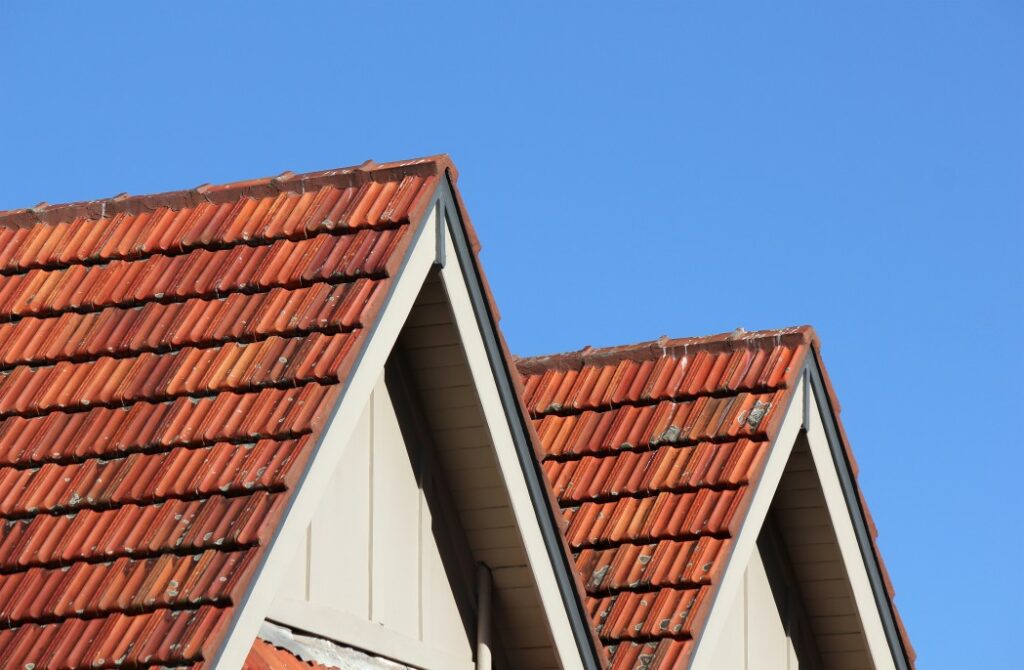
To begin with, there are different types of roofs, each with varying types of materials. These largely come into play under broader categories.
The two common types of roofs are;
The method of construction and materials used to differ in these two classifications. Some other factors include;
It is cheaper to install a new roof in remote areas compared to the houses next to or in cities. This is due to labor costs and demand, among many other reasons.
For example, the neighboring state of California has quite a bit higher installation and roof repair costs than the Phoenix metro area. However, Phoenix is catching up with the influx of new people moving here. According to a roofing company in Los Angeles, a new roof would set you back around $12,500 for an asphalt shingle roof, while metal roofing can cost up to $25,500 or more.
Smaller roofs require less labor input as well as materials. It is easier to install a new roof or a smaller house than a more intricate top.
The cost of installing materials is commonly measured in squares or square feet, making the final price of a new roof dependent on its size.
A pitched roof also requires more safety measures than a flat roof as the task is more complicated.
The price of roofing materials and labor vary from place to place. Although the price of materials has a close range, the labor costs differ from one contractor to another depending on the factors discussed below.
Labor accounts for about 50-60% of the total cost of a new roof. The labor costs may vary in different places due to;
A new roof installed on the house being built will be more costly. This is partially due to the number of different projects involved.
The roof frame is built on the house, including the trusses, rafters, purlins, eaves, and other parts that don't include the material covering. These materials, including labor, amount to more than installing a new roof on a house that had one before.
The price for a new roof on a constructed house depends on:
Other factors that may increase the cost of a new roof will be discussed later.

Sometimes fixing your roof is more expensive than replacing it with a new one. Regular maintenance to fix minor damages allows them to accumulate, which may weaken the roof's integrity.
It becomes costly to fix the damages, which allows the roof's interior to get damaged from exposure to the elements. It is vital to act early to avoid incurring expensive damages.
Signs you need a new roof:
Some straightforward signs since you may not be able to inspect the roof from above
These are some signs of some common roofing materials;
| Material | What to look out for |
| Shingled Roof | Missing shingles Shingles with curled edges Loose shingles |
| Metal Roof | Torn roof parts Curled edges Holes in the sheets Rusted areas Loose sheets- that rattle in the wind |
| Tile Roof | Missing tiles Broken tiles |
Other factors
The manufacturer's recommended replacement age or the roof expiry date plays a considerable role. If your roof is about 80% close to this period, it is crucial to take the necessary steps to install a new roof.
Damage by fire and weather such as storms and hurricanes may lift off huge parts of the roof and therefore force the re-roofing of a house. This may occur even when a roof is healthy, but natural disasters are one the uncontrollable events.

When replacing your old roof with a new one, there are fewer inputs than a new one, but most of this is taken up by labor. The rest of the costs comprise materials and other things such as building permits.
Materials and their availability account for a significant portion of the cost, and their stock availability in the market creates a slight variation in their price. This article gives a relatively common price in most parts provided in price per square feet.
Metal roofs are one of the expensive roofing options. On average, they may cost about $4–$30 per square foot, depending on the type of metal roof and how much labor input is required when installing them.
Metal roofs require relevant expertise in most cases. Below are some of the estimated costs for different metal roofs:
| Roofing Material | Cost |
| Aluminum Shingles | $3.15-$6 |
| Steel Shingles | $3.35-$4.25 |
| Galvalume Corrugated Roofs | $1.50-$2.50 |
| Steel Panel Roof | $0.75-$16 |
| Tin Panels | $3.50-$14 |
| Zinc | $6-$10 |
| Copper Tiles | $14-$15 |
| Standing Seam Panels | $4.50-$6.50 |
Metal roofs are a great investment in areas requiring protection from harsh weather elements and incredibly windy areas.
Asphalt, wood, and metal are all forms of shingles that can be used on roofs. Asphalt shingles are the most popular In terms of shingle and roofing material.
They are not only light in weight but also give a high level of security while being reasonably inexpensive to purchase and install. There are two varieties of asphalt shingles, and they are as follows:
Adhesive and asphalt are combined to create the thin, flat sheets that make up these shingles. They are all the same form and size, with a maximum wind speed of 60 mph or less.
Some construction codes mandate the use of high wind shingles, which makes this type of shingle less prevalent. They have a lifespan of between 7 and 12 years due to their vulnerability to the elements.
Each square foot costs between $1.5 and $3.
Their constitution is identical to 3-tab shingles, but their material quality and quantity differ. These tiles offer a dimensional appearance because of their finer asphalt and many layers.
They can withstand winds up to 120 mph better, with an 80-120 mph rating. If they are correctly cared for, they could last up to 50 years.
The price ranges from $3.50 to $5.00 per square foot, with 50-year shingles costing as much as $15.00 per square foot.
The cost of installing a tile roof can range from $4 to $25, depending on the type of tile used and the average market price in the area.
Wide varieties of tiles are available, each at a varying cost per square foot.
Tiles are heavy roofing materials, and they should be installed on a roof that is sturdy enough.
Labor expenditures make up about 60% of the total cost when replacing a roof. An experienced roofer may be necessary to provide a stable and solid structure.
There are numerous reasons why hiring a professional is always a good idea, such as the dangers of roof installation and the technical expertise they possess. This saves both time and money in the long run by avoiding the need to rectify mistakes made by amateurs.
Metal roofs are more challenging to install than other types of roofing. As a result, the installation price is tied to the kind and size of the roof.
| Material | Cost Per Sq. Ft. |
| Aluminum Shingles | $5.85-$10 |
| Steel Tiles | $6.65-$10.45 |
| Corrugated Tiles | $4.25-$9 |
| Galvalume, Galvanized, and Stainless Steel | $5.50-$15.50 |
| Zinc Panels | $7-$14 |
| Copper Tiles | $6.50-$12 |
Metal roofs require more labor for installation, but they offer long-term protection.
You may need to communicate with the contractor to find out if labor costs are included in the quote or if they are separate.
Listed below are the projected costs per square foot for installing various tiles.
Other unforeseen costs may be included in the final quote. Some of them include:
Your home will be protected from the elements for the long term if you invest in a new roof.
In addition to shielding you from the effects of the weather, it protects the interior of the house, where damage is more difficult to repair and hence more expensive. Your home's worth might also be increased by installing a brand-new roof.
During house staging for sale, the roof is one factor contributing to its quick sale because it does not pass the eyes of house inspections
When the shingles on your roof reach the end of their 20- to 25-year lifetime, you will have to deal with roof repair or replacement at some point.
Choosing the appropriate roofing contractor is essential, and it’s critical to do thorough background checks on potential candidates to verify they’re worth the money.
The installation and maintenance of a roof need specific expertise. Attempting to fix a roof or hiring an untrained roofer might cost a homeowner a lot of money.
So if you need roofing work done, but you've bad credit then look no further! We’ve compiled a list of the finest roofing companies to work with, including tips on selecting the right one.
Complex commercial structures and residential projects are CMR’s specialty areas. When disaster strikes, they can mobilize within 24 to 48 hours thanks to their countrywide network of more than 500 personnel, a team of the best equipment, skills, and relationships.
They have a reputation for executing difficult jobs quickly and on time while maintaining the integrity of our roofing systems.
More than 35 manufacturer certifications, an A+ rating with the Better Business Bureau, and several national, historical, and industry awards for service, success, and workmanship are just some of the accolades CMR has received, including the Inc. 500 honor.
Your dedicated specialist will assist you at every stage of the process to ensure that you have a wonderful experience with CMR—from picking your roofing materials through clean-up and maintenance.
This single point of contact will make the roofing process more efficient, keep you updated on the status of the job, and provide quick response services when you need them. Roofing contractors can assist.
The high standards of CMR’s work begin with the people there. Customers may expect long-lasting protection from their roofs since the company’s personnel is well-versed in examining and installing even the most complicated roofing systems.
As a Ludowici Elite Crown Roofer, they are one of only a few roofers in the country with decades of expertise in the industry.
Each of the company’s 500 workers is committed to giving the best possible service to its residential, business, and public sector customers throughout the country.
They have created a reputation for excellence and a strong business culture that attracts enthusiastic people about their job as a top-10 industry leader.
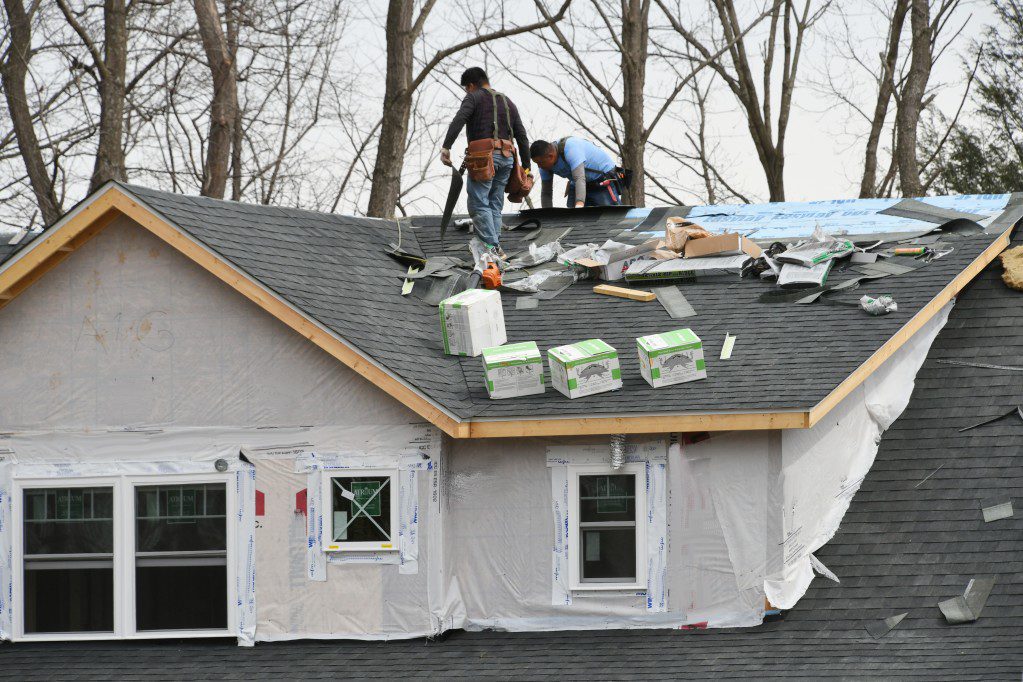
Baker Roofing (formerly known as Baker Rawls Tin Shop) was open for business in Raleigh, North Carolina, in 1915. The message on the sign was, ‘We will do an excellent job.’
It’s always excellent labor regardless of whether it’s profitable or not. The sign may be seen hanging at their Raleigh offices today as a daily reminder of their core beliefs.
Founded in 1915, Baker Roofing is now one of the biggest and most reputable roofing companies in the United States. There are currently more than 20 Baker Roofing Company facilities in the Southeast, and they operate all over the United States.
A company operating for more than a century is no walk in the park. Values-based family ownership and an enduring desire to conduct Always Good Work are probably responsible for its accomplishment.
Founded in North Carolina, Lowe’s has become one of the world’s leading home improvement businesses. It was their goal to assist homeowners, renters, and professionals in improving their houses and companies, both then and now.
Built on the motto, ‘everything we do revolves around the individuals we serve- if you’re looking for help with your home renovation job, go no further than their partners. They’ve constructed their company to be there for you when you need them most, whether it’s an emergency repair or your dream redesign.
Lowe’s business model is based on putting the needs of our customers first. Each of them is working toward a common goal: to provide the most outstanding possible home improvement goods and services to our customers in every channel and community we serve.
Installing roofs in one day is possible for this company. Their inspections and estimates are always free, and stand by everything they sell.
We flourish at Able Roof because we treat everyone with respect, foster a family-like atmosphere at work, give back to the community, and plan to stay ahead of the curve in the roofing business.
Because of their dedication to the community and their trade skills, Able Roof is happy to assist prominent charitable organizations.
From modest beginnings with a single truck and an acute awareness of the needs of local homes, Able Roof has grown into a full-service roofing company.
A commitment to quality and a strong work ethic eventually led to the expansion of the business into siding, gutters, brickwork, windows, and insulation.
Crane Renovation Group’s parent firm, Crane Group, acquired Able Roof in 1997. Because they’ve been in the business for so long, they’re well-positioned to fulfill the demands of today’s renovators while also building on decades of expertise.
As a member of the Crane Renovation Group, they have access to the best products and warranties in the business.
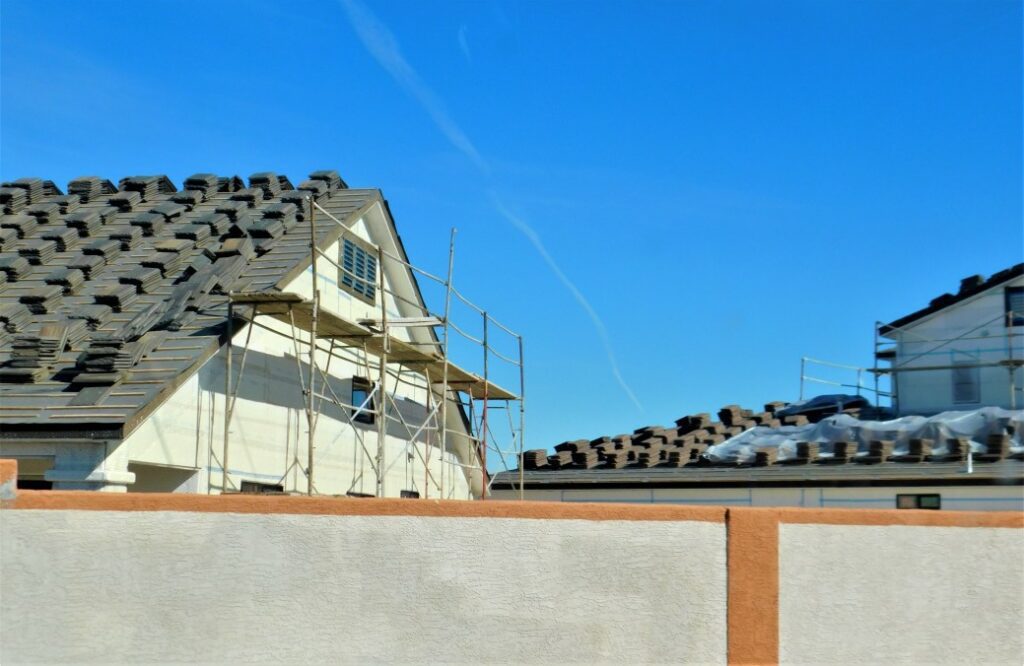
San Antonio, Texas-based BELDON is a multi-award-winning business. LeafGuard® gutters, Pella® replacement windows, ProVia replacement doors, James Hardie fiber cement siding, and commercial and residential roofing systems are just a few of the goods this family-owned and run company has had since its inception in 1946.
BELDON® Roofing Company has been in bloom for four generations and 75 years, making it one of the city’s most prominent enterprises with lengthy honors and achievements. The San Antonio Business Journal honored the firm with a Family-Owned Business Award in June of this year.
As a family-owned firm, BELDON® Roofing Company has always been committed to three essential values: integrity, innovation, and immersion.
Aspen Contracting Inc. is among the top country roofing firms. The company’s headquarters are in Lee’s Summit, Kansas, with offices around the country.
If you have a broken roof, siding, or gutter that needs fixing, you can rely on Aspen Contracting to get the job done.
Due to the Aspen tree’s extensive roots, it was given the name Aspen Contracting. Fire, flood, storm, and ice do not match these roots.
The Aspen tree’s roots have long been recognized as the world’s longest-living organism, with a lifespan of over 80,000 years. Aspen trees offer each other their leading roots when they need them. An organization like this one will never go out of business and always be there for those in need. Aspen Contracting is unflappable in the face of adversity.
It’s all on you now - A Project Consultant will be assigned to you when you phone Aspen Contracting to set up your free inspection and proposal.
For the duration of your project, Project Consultants will help you along the way. Your allocated consultant will handle your project from start to finish, so you don’t have to worry about searching for the correct department for issues!
Aspen’s staff works with all building agencies to ensure that all regulations, permits, and inspections are completed appropriately.
To manage any job, they undergo extensive training and certification. They work with the local governments to facilitate a seamless transition for a successful outcome.
When it comes to measuring roofs, siding, and gutters, human error is almost inevitable. Aspen uses the most up-to-date technologies for every job to assure the highest level of precision, whether it be siding and gutters or a roof repair.
Aspen Contracting requires all personnel to be certified by manufacturers and attend training seminars before they can begin work.
All workers must attend weekly safety and education training sessions to maintain their high-quality standards. All Aspen projects are guaranteed to last a long time because of the use of high-quality components, some of which are exclusive.
Quality control checklists are completed before, during, and after each project.
The first step is a free quotation and inspection from the business. They pledge not to charge you until the job is finished and you are happy with it.
Aspen’s goal is to complete the work correctly from start to finish. For both the client and the environment, this is the best option.
In other words, Aspen is committed to reducing, reusing, and recycling as much as possible. Aspen allows consumers to recycle outdated roofing materials such as shingles, nails and gutters, and aluminum and steel siding.
These materials can be recycled, which reduces the amount of garbage that goes to landfills.
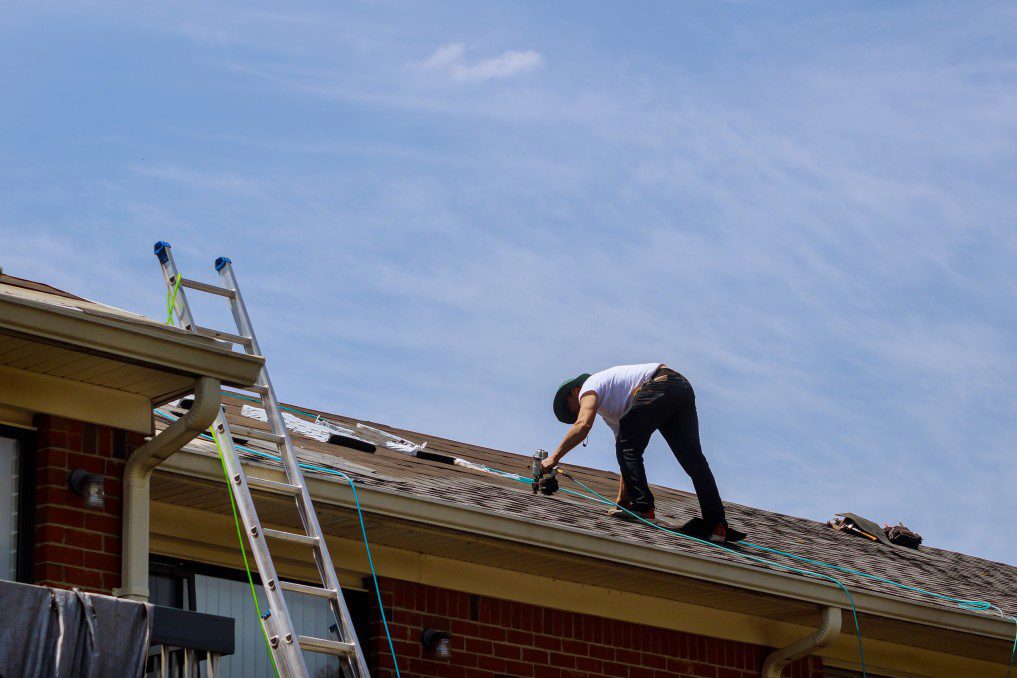
Lanier family members have owned and operated Collis Roofing since its inception in 2004. Roofing contractors in Florida provide more free roofs and repairs to widows, the elderly, families coping with crises, and charitable organizations like Habitat for Humanity than any other contractor in the state.
Nonprofit organizations such as Give Kids the World and The Russell Home get financial assistance from Collis Roofing each year through charitable donations and volunteer time.
As a licensed and insured contractor in Florida, Collis Roofing is limited to serving the state. Florida’s residential and commercial roofing contractors rely on them for their roofing needs.
Roofers in the United States, Canada, and the Bahamas rank 23rd in the nation compared to all roofing firms.
Using E-Verify, the US Department of Homeland Security has certified that every Collis Roofing employee has legally entitled to work in the United States.
Collis Roofing adheres to a zero-tolerance drug and alcohol policy, including random drug testing for new hires.
The United Safety Council has recognized Collis Roofing with various accolades. Everyone working on a building site must have completed and passed a comprehensive safety training program.
Every year, each employee must complete and pass a new safety course. Daily, the organization does frequent toolbox lectures and on-the-job inspections and employs a Multi Certified Safety Director.
A GPS monitors speed and sends out alarms if the car is going too fast.
“Roofs In Need” is a project that Interstate Roofing is happy to support and create. This is their yearly effort to select a worthy homeowner who cannot afford to repair the roof on their house due to life’s circumstances.
Interstate Roofing brings together its resources and manufacturers to give a new roof to a chosen homeowner.
As we’ve become used to having it, many of us don’t give it much thought. Do they often consider the roofs over our heads when they think about what they are grateful for? To ensure you and your family’s safety, Interstate Roofing will install the finest roof we can.
Understand that some families in the Colorado neighborhood do not have a roof over their heads. Interstate Roofing is sponsoring the Roofs in Need initiative to alleviate their stress and change their despair and hopelessness into sentiments of appreciation.
Just like Roofs In Need, which provides new roofs to low-income families in need, the firm is helping to build a better, more loving community by doing good deeds for the community.
The self-lifting feelings of giving and gratitude are far better than those of desperation and helplessness – that’s why every year, they reach out to extended Colorado families to nominate a family needing a new roof.
Total Home Roofing has been listed in the Top 50 roofing contractors nationwide for the past five years.
The Total Home Roofing team comprises only the nation’s most reliable, experienced, and dependable staff. Along with being ranked in the Top 50, Total Home Roofing also has an A+ rating from BBB and has won many awards for customer service to top-of-the-line quality.
As a Platinum Preferred Contractor with Owens Corning, you can always count on their services.
It only uses the industry’s finest and most durable materials and offers a wide range of financing options to fit your needs.
Ready to get started? Total Home Roofing offers both Virtual and Online appointments.
The choice is easy as the Highest Reviewed Roofer in the Nation-Top Rated on Home Advisor & Angie’s List.